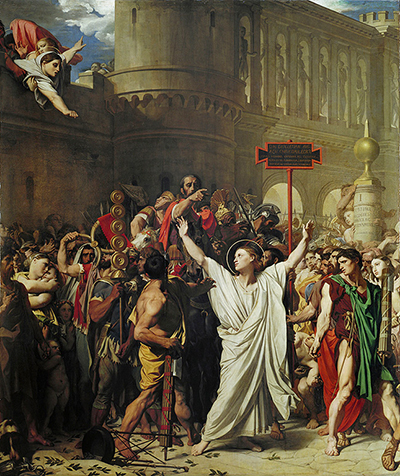Ingres completed The Martyrdom of Saint Symphorian in 1834 and immediately considered it to be one of his finest ever creations, a huge piece standing at an extraordinary 407cm tall by 339cm wide.
This powerful scene is packed full of figures, as well as allowing the artist to also display his talent for depicting architecture within paintings too. The central figure raises their hands in desperation, shortly before being punished for refusing to worship a pagan Goddess (Cybele). Hence the title of martyr for this painting. The lady reaching out is the saint's mother, and she instils a confidence and strength in her child that all will be well, whatever occurs. This classicist approach has been compared to influences from Raphael plus also the more recent work of Delacroix.
Ingres had fought for many years to be accepted as a history painter but this piece was not to be received in the way he had hoped. The early display of this artwork continued the critics general rejection of his work in this genre, still insisting that his true ability lied in portraiture. It was first exhibited at the influential Paris Salon in 1834, the same year in which he completed the piece. Ingres had been trying to build a reputation as a history painter for many years, due to the larger payments that commissions in this field would bring. He also felt that installed artworks in notable venues would also bring a boost to his overall legacy as an artist.
The Cathedral of Saint Lazarus of Autun, also known more simply as Autun Cathedral, is the home to this exceptional artwork. This imposing building in central France has a long history in hosting highly significant original art over the past few centuries, including both architecture and oil paintings. Perhaps the finest artwork to have appeared on display in the Cathedral would have to be Madonna of Chancellor Rolin by Jan van Eyck which was hosted here between the years of 1793 and 1805. Currently the finest piece of architecture would be Last Judgment by Gislebertus and this venue is well worth a visit whether for religious or artistic interests.




